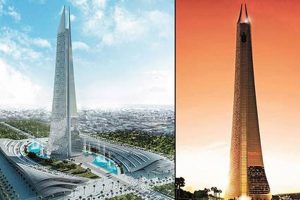Skyscrapers are defined as buildings having over 40 floors and a minimum height of 150 meters. Italy is home to some of the tallest and most iconic skyscrapers in Europe. The tallest skyscraper in Italy is the Unicredit Tower in Milan, which stands at 231 meters tall. Other notable skyscrapers in Italy include the Torre Allianz in Milan, the Generali Tower in Trieste, and the Intesa Sanpaolo Tower in Turin.
Skyscrapers play an important role in Italy’s economy and culture. They provide much-needed office space in densely populated urban areas and are often home to major corporations and financial institutions. Skyscrapers also contribute to Italy’s tourism industry, as they are often landmarks and attractions in their own right.
The construction of skyscrapers in Italy began in the early 20th century, with the first skyscrapers being built in Milan and Turin. The construction of skyscrapers continued throughout the 20th century, and there was a boom in skyscraper construction in the 1960s and 1970s. Today, skyscrapers are a common sight in major Italian cities, and they continue to be built to meet the growing demand for office space and housing.
1. Tall
Skyscrapers are defined as buildings having over 40 floors and a minimum height of 150 meters. Italy is home to some of the tallest and most iconic skyscrapers in Europe. The tallest skyscraper in Italy is the Unicredit Tower in Milan, which stands at 231 meters tall. Other notable skyscrapers in Italy include the Torre Allianz in Milan, the Generali Tower in Trieste, and the Intesa Sanpaolo Tower in Turin.
- Height
The height of a skyscraper is one of its most defining characteristics. Skyscrapers are built tall to maximize the amount of office space that can be accommodated within a given footprint. The height of a skyscraper can also be a symbol of power and prestige. - Structural Engineering
Skyscrapers require specialized structural engineering techniques to ensure that they can withstand the forces of wind, earthquakes, and other environmental factors. The structural design of a skyscraper must also take into account the weight of the building and the materials used in its construction. - Architectural Design
The architectural design of a skyscraper is an important consideration, as it can affect the building’s overall appearance and functionality. Skyscrapers can be designed in a variety of styles, from modern to classical. The architectural design of a skyscraper can also be influenced by the surrounding environment. - Sustainability
Skyscrapers can be designed to be sustainable by incorporating energy-efficient features and materials. Sustainable skyscrapers can help to reduce the environmental impact of buildings and can also be more cost-effective to operate.
The height of Italy’s skyscrapers is a testament to the country’s engineering and architectural prowess. These buildings are not only symbols of Italy’s economic and technological progress, but also of its commitment to sustainability and innovation.
2. Iconic
Italy’s skyscrapers are iconic landmarks that have become synonymous with the country’s economic and cultural achievements. These buildings are not only symbols of Italy’s technological prowess, but also of its architectural heritage and cultural identity.
- Architectural Landmarks
Italy’s skyscrapers are architectural landmarks that have come to define the skylines of major Italian cities. These buildings are often designed by world-renowned architects and feature innovative and eye-catching designs. The Unicredit Tower in Milan, for example, is known for its distinctive sail-like shape, while the Torre Allianz in Milan is known for its twisted form. - Symbols of Economic Power
Italy’s skyscrapers are also symbols of the country’s economic power and prosperity. These buildings are often home to major corporations and financial institutions, and their presence in a city is often seen as a sign of economic vitality. The Intesa Sanpaolo Tower in Turin, for example, is the tallest skyscraper in Italy and is a symbol of the city’s status as a major financial center. - Cultural Heritage
Italy’s skyscrapers are also part of the country’s cultural heritage. These buildings are often designed to reflect the history and culture of the city in which they are located. The Generali Tower in Trieste, for example, is designed to resemble a traditional Venetian palace, while the Torre Velasca in Milan is designed to resemble a medieval tower. - Tourist Attractions
Italy’s skyscrapers are also popular tourist attractions. These buildings offer stunning views of the surrounding city and often house observation decks and other tourist amenities. The Unicredit Tower in Milan, for example, offers a 360-degree view of the city from its observation deck, while the Torre Allianz in Milan houses a museum and a restaurant.
The iconic status of Italy’s skyscrapers is a testament to the country’s rich architectural heritage, economic power, and cultural identity. These buildings are not only symbols of Italy’s past and present, but also of its future potential.
3. Modern
Italy’s skyscrapers are a testament to the country’s commitment to modernity. These buildings are not only symbols of Italy’s economic and technological progress, but also of its architectural and cultural heritage.
Skyscrapers are a relatively new phenomenon in Italy, with the first skyscrapers being built in the early 20th century. However, skyscrapers quickly became a popular way to accommodate the growing population of Italian cities. Today, skyscrapers are a common sight in major Italian cities such as Milan, Rome, and Turin.
Italy’s skyscrapers are designed in a variety of modern styles. Some skyscrapers, such as the Unicredit Tower in Milan, are designed in a sleek and minimalist style. Other skyscrapers, such as the Torre Velasca in Milan, are designed in a more traditional style. However, all of Italy’s skyscrapers are designed to be functional and efficient.
The construction of skyscrapers in Italy has had a number of positive impacts on the country. Skyscrapers have provided much-needed office space in densely populated urban areas. Skyscrapers have also contributed to Italy’s tourism industry, as they are often landmarks and attractions in their own right.
The construction of skyscrapers in Italy is a continuing trend. As Italian cities continue to grow, the demand for office space and housing will continue to increase. Skyscrapers are a sustainable way to meet this demand, as they can be built to be energy-efficient and environment
ally friendly.
Italy’s skyscrapers are a symbol of the country’s modernity and progress. These buildings are not only functional and efficient, but also beautiful and iconic. Italy’s skyscrapers are a testament to the country’s commitment to innovation and sustainability.
4. Functional
Skyscrapers are not just symbols of economic power and architectural prowess; they are also functional buildings that serve a variety of purposes. Italy’s skyscrapers are no exception. These buildings are designed to be efficient and practical, providing much-needed office space and other facilities in densely populated urban areas.
- Office Space
The primary function of most skyscrapers is to provide office space. Skyscrapers can accommodate a large number of tenants in a relatively small footprint, making them an efficient way to use land in densely populated urban areas. Italy’s skyscrapers are home to a variety of businesses, including banks, law firms, and consulting companies. - Residential Space
In recent years, there has been a growing trend towards building skyscrapers that include residential units. These skyscrapers offer a variety of advantages over traditional apartments, including stunning views, access to amenities, and increased security. Italy’s skyscrapers are increasingly including residential units, as more and more people are choosing to live in urban areas. - Retail Space
Many skyscrapers also include retail space on the lower floors. This can be a convenient amenity for tenants and visitors, and it can also help to generate revenue for the building owners. Italy’s skyscrapers often include retail space that caters to the needs of the surrounding community. - Other Amenities
In addition to office, residential, and retail space, skyscrapers can also include a variety of other amenities, such as conference rooms, fitness centers, and restaurants. These amenities can help to make skyscrapers more attractive to tenants and visitors, and they can also contribute to the overall functionality of the building.
The functional design of Italy’s skyscrapers is a testament to the country’s commitment to efficiency and practicality. These buildings are designed to meet the needs of businesses and residents alike, and they play an important role in the economic and social fabric of Italian cities.
5. Sustainable
Sustainability is a key consideration in the design and construction of Italy’s skyscrapers. Skyscrapers are inherently energy-intensive buildings, but they can be designed to be more sustainable by incorporating energy-efficient features and materials.
- Energy Efficiency
Italy’s skyscrapers are designed to be energy efficient by incorporating features such as high-performance glazing, LED lighting, and efficient HVAC systems. These features can help to reduce the building’s energy consumption and operating costs. - Renewable Energy
Some Italy’s skyscrapers are equipped with renewable energy systems, such as solar panels and wind turbines. These systems can help to reduce the building’s reliance on fossil fuels and generate clean energy. - Water Conservation
Italy’s skyscrapers are designed to conserve water by incorporating features such as low-flow plumbing fixtures and rainwater harvesting systems. These features can help to reduce the building’s water consumption and operating costs. - Sustainable Materials
Italy’s skyscrapers are constructed using sustainable materials, such as recycled steel and concrete. These materials can help to reduce the building’s environmental impact and improve its durability.
The sustainable design of Italy’s skyscrapers is a testament to the country’s commitment to sustainability and innovation. These buildings are not only energy-efficient and environmentally friendly, but they are also beautiful and iconic. Italy’s skyscrapers are a symbol of the country’s modernity and progress.
6. Economically important
Skyscrapers are economically important for a number of reasons. First, they provide much-needed office space in densely populated urban areas. This can help to attract businesses and investment to a city, which can lead to economic growth. Second, skyscrapers can be used to house a variety of businesses, from small startups to large corporations. This can create a diverse and vibrant economy in a city. Third, skyscrapers can be a source of revenue for a city through property taxes and other fees. This revenue can be used to fund public services and infrastructure, which can benefit all residents of a city.
Italy’s skyscrapers are no exception. They play an important role in the country’s economy. For example, the Unicredit Tower in Milan is the headquarters of one of Italy’s largest banks. The Torre Allianz in Milan is home to a number of multinational corporations. And the Intesa Sanpaolo Tower in Turin is a major financial center.
The economic importance of Italy’s skyscrapers is likely to continue to grow in the future. As the country’s economy continues to grow, there will be an increasing demand for office space in urban areas. Skyscrapers are a sustainable way to meet this demand, as they can be built to be energy-efficient and environmentally friendly.
7. Culturally significant
Skyscrapers are not just symbols of economic power and technological prowess; they are also cultural icons that reflect the values and aspirations of a society. Italy’s skyscrapers are no exception. These buildings are not only symbols of Italy’s economic and technological progress, but also of its cultural heritage and identity.
- Architectural Landmarks
Italy’s skyscrapers are architectural landmarks that have come to define the skylines of major Italian cities. These buildings are often designed by world-renowned architects and feature innovative and eye-catching designs. The Unicredit Tower in Milan, for example, is known for its distinctive sail-like shape, while the Torre Allianz in Milan is known for its twisted form. - Symbols of National Pride
Italy’s skyscrapers are also symbols of national pride. These buildings represent the country’s economic and technological achievements, and they are often seen as a source of inspiration for Italians. The Intesa Sanpaolo Tower in Turin, for example, is the tallest skyscraper in Italy and is a symbol of the city’s status as a major financial center. - Tourist Attractions
Italy’s skyscrapers are also popular tourist attractions. These buildings offer stunning views of the surrounding city and often house observation decks and other tourist amenities. The Unicredit Tower in Milan, for example, offers a 360-degree view of the city from its observation deck, while the Torre Allianz in Milan houses a museu
m and a restaurant. - Cultural Heritage
Italy’s skyscrapers are also part of the country’s cultural heritage. These buildings are often designed to reflect the history and culture of the city in which they are located. The Generali Tower in Trieste, for example, is designed to resemble a traditional Venetian palace, while the Torre Velasca in Milan is designed to resemble a medieval tower.
The cultural significance of Italy’s skyscrapers is undeniable. These buildings are not only symbols of Italy’s past and present, but also of its future potential. Italy’s skyscrapers are a testament to the country’s commitment to innovation, sustainability, and cultural heritage.
8. Tourist attractions
Italy’s skyscrapers are not just symbols of economic power and architectural prowess; they are also popular tourist attractions. These buildings offer stunning views of the surrounding city and often house observation decks and other tourist amenities.
- Observation decks
Many of Italy’s skyscrapers have observation decks that offer panoramic views of the surrounding city. These observation decks are a popular tourist attraction, as they provide a unique opportunity to see the city from a different perspective. Some of the most popular observation decks in Italy include the Unicredit Tower in Milan, the Torre Allianz in Milan, and the Intesa Sanpaolo Tower in Turin. - Museums and exhibits
Some Italy’s skyscrapers house museums and exhibits that are open to the public. These museums and exhibits often focus on the history and architecture of the skyscraper, or on the city in which it is located. Some of the most popular museums and exhibits in Italy’s skyscrapers include the Museum of the Clouds in the Torre Allianz in Milan, and the Museum of the City of Turin in the Intesa Sanpaolo Tower in Turin. - Restaurants and bars
Many Italy’s skyscrapers have restaurants and bars that are open to the public. These restaurants and bars often offer stunning views of the surrounding city, and they are a popular place to relax and enjoy a meal or a drink. Some of the most popular restaurants and bars in Italy’s skyscrapers include the Ceresio 7 in the Torre Allianz in Milan, and the Piano35 in the Intesa Sanpaolo Tower in Turin. - Other amenities
In addition to observation decks, museums, and restaurants, Italy’s skyscrapers often have other amenities that are open to the public. These amenities may include fitness centers, pools, and spas. Some of the most popular amenities in Italy’s skyscrapers include the fitness center in the Unicredit Tower in Milan, and the pool in the Torre Allianz in Milan.
The tourist attractions in Italy’s skyscrapers are a major draw for visitors to the country. These attractions offer a unique opportunity to experience the country’s rich history, culture, and architecture. Whether you are interested in stunning views, fascinating museums, or delicious food, you are sure to find something to enjoy in Italy’s skyscrapers.
9. Symbols of progress
Skyscrapers have long been seen as symbols of progress and modernity. They represent a city’s ambition and its desire to reach for the sky. Italy’s skyscrapers are no exception. These buildings are not only symbols of Italy’s economic and technological progress, but also of its cultural and social progress.
- Economic progress
Skyscrapers are often built during periods of economic growth and prosperity. They represent a city’s confidence in its future and its ability to attract new businesses and investment. Italy’s skyscrapers are a testament to the country’s strong economy and its commitment to innovation. - Technological progress
Skyscrapers are also symbols of technological progress. They represent the latest in construction and engineering techniques. Italy’s skyscrapers are some of the tallest and most innovative in the world. They are a testament to the country’s engineering prowess and its commitment to sustainability. - Cultural progress
Skyscrapers can also be seen as symbols of cultural progress. They represent a city’s openness to new ideas and its willingness to embrace change. Italy’s skyscrapers are often designed by world-renowned architects and feature cutting-edge design. They are a testament to the country’s rich cultural heritage and its commitment to the arts. - Social progress
Skyscrapers can also be seen as symbols of social progress. They represent a city’s commitment to providing its citizens with a high quality of life. Italy’s skyscrapers are often located in mixed-use developments that include residential, commercial, and retail space. They are a testament to the country’s commitment to creating livable and sustainable cities.
Italy’s skyscrapers are more than just tall buildings. They are symbols of the country’s progress and its commitment to the future. These buildings are a source of pride for Italians and a testament to the country’s economic, technological, cultural, and social achievements.
FAQs about Italy’s skyscrapers
Skyscrapers are an essential part of Italy’s modern landscape. They provide much-needed office space in densely populated urban areas and are often home to major corporations and financial institutions. Skyscrapers also contribute to Italy’s tourism industry, as they are often landmarks and attractions in their own right.
Here are some frequently asked questions about Italy’s skyscrapers:
Question 1: What is the tallest skyscraper in Italy?
The tallest skyscraper in Italy is the Unicredit Tower in Milan, which stands at 231 meters tall.
Question 2: How many skyscrapers are there in Italy?
There are over 100 skyscrapers in Italy, with the majority of them located in Milan, Rome, and Turin.
Question 3: What are some of the most famous skyscrapers in Italy?
Some of the most famous skyscrapers in Italy include the Unicredit Tower in Milan, the Torre Allianz in Milan, the Generali Tower in Trieste, and the Intesa Sanpaolo Tower in Turin.
Question 4: What are the benefits of building skyscrapers?
Skyscrapers provide a number of benefits, including increased office space, improved energy efficiency, and reduced traffic congestion.
Question 5: What are the challenges of building skyscrapers?
Skyscrapers can be challenging to build due to their height and complexity. They require specialized engineering and construction techniques, and they can be expensive to build and maintain.
Question 6: What is the future of skyscrapers in Italy?
The future of skyscrapers in Italy is bright. As the country’s economy continues to grow, there will be an increasing demand for office space in urban areas. Skyscrapers are a sustainable way to meet this demand, as they can be built to be energy-efficient and environmentally friendly.
Skyscrapers are an important part of Italy’s modern landscape and are likely to continue to play a vital role in the country’s economic and social development.
Transition to the next article section..
.
Tips for visiting Italy’s skyscrapers
Skyscrapers are an essential part of Italy’s modern landscape. They offer stunning views of the surrounding city and often house observation decks and other tourist amenities. Here are some tips for visiting Italy’s skyscrapers:
Tip 1: Do your research
Before you visit a skyscraper, take some time to do your research. Find out how tall the building is, how many floors it has, and what kind of views it offers. This will help you decide if the skyscraper is worth visiting and what to expect when you get there.
Tip 2: Book your tickets in advance
Many skyscrapers require you to book your tickets in advance, especially if you want to visit the observation deck. This is especially important during peak tourist season. You can usually book tickets online or by phone.
Tip 3: Arrive early
If you want to avoid the crowds, arrive early at the skyscraper. This will give you plenty of time to explore the building and enjoy the views without having to wait in long lines.
Tip 4: Take your time
Don’t rush your visit to a skyscraper. Take your time to explore the building and enjoy the views. There is no need to hurry, and you will have plenty of time to take in the sights.
Tip 5: Be respectful
Skyscrapers are often busy places, so be respectful of other visitors. Don’t be loud or disruptive, and follow the instructions of the staff.
Tip 6: Enjoy the views
The best part of visiting a skyscraper is the views. Take some time to enjoy the pemandangan from the observation deck. You will be able to see the city from a whole new perspective.
Tip 7: Take some photos
Don’t forget to take some photos of your visit to the skyscraper. You will want to remember the experience and share it with your friends and family.
Tip 8: Have fun
Visiting a skyscraper is a great way to see the city and have some fun. Enjoy the experience and make some memories.
Summary
Following these tips will help you have a great visit to Italy’s skyscrapers. These buildings are a great way to see the city and experience the country’s culture and history.
Italy’s skyscrapers
Italy’s skyscrapers are not just tall buildings; they are symbols of the country’s economic, technological, cultural, and social progress. These buildings represent Italy’s commitment to innovation, sustainability, and the future. Whether you are a tourist visiting for the first time or a local resident, be sure to take some time to appreciate the beauty and significance of Italy’s skyscrapers.
As Italy continues to grow and develop, its skyscrapers will continue to play a vital role in the country’s economy and society. These buildings are a testament to Italy’s rich history and culture, and they will continue to be a source of pride for Italians for generations to come.







